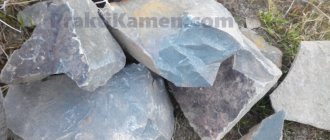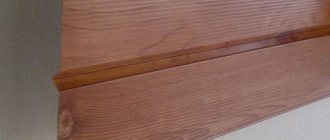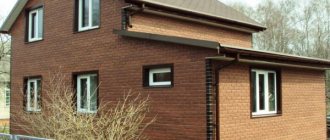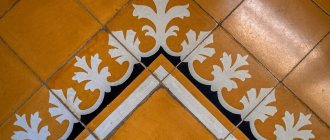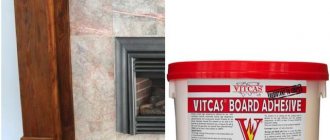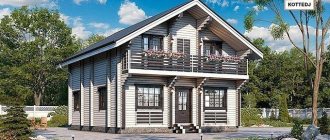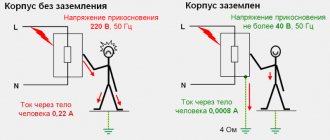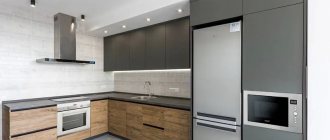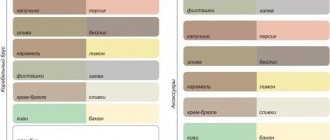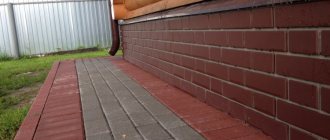- Features of the material
- For outdoor areas
- For indoor use
- How is flexible stone produced?
- Characteristics of flexible stone
- Technological features in interior design
- Mistakes when designing premises
- Areas of application of decorative flexible stone
- How to use it when creating an interior
- Decorating the facade of the house
- In the living room
- In the kitchen
- In the hall
- In bathroom
- Advantages
- Disadvantages of flexible material
- Usage
- Finishing technology and care
- Leading manufacturers of flexible stone
- Features of making flexible stone with your own hands
- How much does flexible stone cost for facade and interior decoration - price review
- Conclusion
Features of the material
Flexible stone is a thin section of sandstone in which the natural pattern is preserved after being applied to a flexible base. Not every breed is suitable for these purposes, so it is used only with a porous texture.
The prepared cladding is produced in two types:
- tiles with a thin layer of stone (up to 3-4 mm);
- polymer rolls with applied stone cut.
Premises with such finishing are distinguished by a favorable microclimate, since the flexible stone is vapor-permeable (breathes, receiving and releasing fumes). This is an excellent cladding for different types of premises.
For outdoor areas
Cladding of the facade and individual architectural elements, as well as chimneys, greenhouses, balconies and loggias, terraces and verandas.
For indoor use
Cladding of walls and various structural elements, as well as columns, fireplaces, finishing of the bathroom and pool, niches and arches, complex ceiling structures and inclined surfaces of the loggia.
The lining is applied to the prepared surface; it must be even and smooth. But if there are small cracks, stains, smudges and other defects, a flexible stone will hide these defects.
This innovative material is made from natural raw materials, but a technology has also been developed for the production of artificial “wild stone”, produced in rolls. Both options have excellent aesthetic properties; they are in harmony with other cladding on a natural and synthetic basis.
Surfaces treated with flexible stone look most organic:
- in the hall;
- in corridors and passages;
- in recreational areas;
- in large foyers and waiting rooms;
- in the greenhouse, on the loggia and balcony;
- in the living room combined with a loggia;
- in a spacious bathroom or mini-pool;
- on the staircases.
Decorative tiles, brick-like and other types
There are three main types:
1) Wallpaper or rolls , some suppliers call this type “sheets”. It is the most popular option. They are produced in the form of a canvas with a thickness (on average) of 1 mm, which is sold rolled up, i.e. in rolls of various sizes. But there are also standard dimensions - 1200x2600 mm. Wallpaper is the optimal solution for wall cladding ; it is most often used for interior decoration. The rolls easily lie on a smooth surface, on objects of convex and concave shapes, and follow the curves of the base, emphasizing the relief. Installation is carried out using almost the same technology as conventional wallpaper, i.e. the canvases are fixed to the surface using an adhesive composition . Manufacturers offer a large number of interesting solutions : flexible stone to look like bricks, applying frescoes to canvases, etc. Some enterprises offer favorable conditions for purchase.
Attention. Installation is carried out WITHOUT overlapping one sheet onto another. The volumetric texture will only highlight finishing errors.
2) Tiles. The main difference from the first type is the thickness, which is 2.5 mm. Tiles are available in a wide variety of sizes. The minimum standard is 80x265 mm, the maximum is 340x550 mm. This allows you to use tiles both for wall cladding and for decorating individual areas: arched vaults, steps, fireplaces, etc. Manufacturers meet customers halfway and produce products in individual sizes . Color solutions are limited only by the imagination of businesses and consumers. Natural-looking tiles that imitate natural noble materials are available for sale.
3) Thermal panels. All types of stone cladding have increased heat resistance, but for finishing stoves, saunas, fireplaces, chimneys and other surfaces that heat up to significant temperatures, it is recommended to use thermal panels. They can easily withstand temperatures up to 700 degrees. They are also used for cladding facades, balconies and loggias, walls and other surfaces. Extruded polystyrene foam or façade foam is used as a base.
How is flexible stone produced?
The technology was developed in Germany, after which it quickly gained popularity in Europe. The method remains the same from different manufacturers, only the base on which the natural material is applied differs, and its design also varies.
For the manufacture of cladding, quarry sandstone with high aesthetic merits is required. A thin section is polished and prepared for application to the base (MDF, plastic tiles, polymer canvas). The stone is rolled onto the base, and the grains form a unique natural pattern, for example, soft stones for the interior.
The low density of sandstone and its pleasant texture make it the most sought-after raw material for innovation. The natural texture is preserved, and working with such cladding is a pleasure.
Characteristics of flexible stone
The material combines the properties of synthetic and natural finishes:
- The stone does not support the combustion process, therefore it is absolutely fire resistant.
- It tolerates temperature fluctuations well and is suitable for cladding surfaces adjacent to heating devices (fireplaces, stoves, chimneys).
- It is durable and has a long service life.
- Flexible stone does not require complex maintenance.
- Maintains an optimal level of humidity in the room and promotes complete gas exchange.
- Creates an environmentally friendly environment and creates a homely atmosphere.
- Due to its low weight, it does not create a large load on the building, as happens with stone tiles.
- Original material for solving various design problems and exclusive projects.
- It is not saturated with kitchen odors; soft stone in the interior does an excellent job of absorbing fine suspended matter.
Advantages of flexible stone due to its production technology
Despite the fact that the layer of sandstone on flexible stone is very thin, thanks to it this material has all the properties of natural stone. It is environmentally friendly, wear-resistant, insensitive to moisture and steam, withstands significant temperature fluctuations and does not burn. Therefore, unlike conventional textile wallpaper, flexible stone can be used to decorate walls and ceilings in saunas, baths, swimming pools and unheated rooms. And the material with a thick layer of sandstone is perfect for finishing the facades of buildings, even in those regions where the frost drops below -10C in winter.
Another significant advantage for people who prefer natural shades in the interior will be the color scheme of flexible stone - it exactly repeats the fancy texture of sandstone. Manufacturers claim that there are no two absolutely identical rolls of this material, since nature does not stamp copies and the design on each stone is unique.
Another part of the advantages of flexible stone is due to the technical characteristics of this material. Since it is very flexible and can be perfectly cut into pieces of any shape and length, such “stone wallpaper” can be used to cover even the most complex architectural forms - arches, columns, fireplaces
Moreover, it is important that during installation, the joints between individual pieces of material are practically invisible to the naked eye, so after finishing the interior looks as if everything is lined with solid stone.
Technological features in interior design
This material will show its high qualities if it is installed correctly. You need to pay attention to avoid such problems:
Since flexible stone has a high price, there are fakes on the market. Sellers promise full-fledged material for a significantly lower price. By purchasing low-quality flexible stone, the buyer risks receiving a material that cannot be bent in such a way that it fits a complex surface.
Usually, fake flexible stone crumbles easily. The fake material does not use acrylic solution, but instead uses epoxy. This significantly reduces quality and durability.
When gluing, you need to use the glue recommended by the manufacturer. If the instructions do not indicate this, you can choose it yourself. High-quality acrylic-based glue is suitable. Otherwise, the quality of attachment is not guaranteed.
For this material, additional processing must be carried out after installation. It is coated with a special compound in order to improve its resistance to moisture. If this is not done, the service life will be shortened.
A flat surface is required to use it. After gluing a thin layer, wall unevenness, if any, will be visible.
Mistakes when designing premises
The high quality and high cost of the material impose special responsibility on the designer when decorating the interior.
Here are some of them:
- When decorating small apartments, it is not recommended to overload the interior with a large number of complex details. This creates a feeling of overload.
- The use of flexible stone should be in harmony with the color and arrangement of the furniture, emphasizing the impression of it.
- The variety of colors of the proposed material can be used to zone a room. This will be difficult to change in the future, which will lead to the design becoming boring and irritating.
- Flexible stone can be used to create murals. If they are done poorly, it will create the impression of a tacky interior.
- When decorating, it is not recommended to limit yourself to one color. You need to use this material so that there are several of them in the interior. It is believed that the three colors will look harmonious.
- When using such material, possible mistakes must be avoided. The fact that flexible stone is expensive makes it necessary to create high-quality designs using it.
Pros and cons of the material
Any building material, regardless of type and cost, has advantages and disadvantages. As for decorative flexible stone for finishing facades, its obvious advantages include:
- Absence of substances harmful to the human body;
- Easy installation;
- Impact resistance – soft material is difficult to break accidentally;
- Wear resistance - flexible stone is not afraid of ultraviolet radiation, does not wear off or erode;
- Moisture resistance – the material almost does not absorb water;
- Low water permeability;
- High level of fire resistance;
- Light weight;
- Lack of special care;
- Long service life;
- Preservation of all qualities at temperatures from -45 to +650C;
- The flexibility of the material allows you to give the façade the most unpredictable configurations.
The versatility of the material, combined with the fact that it can be used to implement bold design solutions, has undoubtedly made it a leader in the market of building materials used for finishing the facades of houses.
True, an impressive list of advantages does not mean that flexible stone is without disadvantages. More precisely, it has only one drawback - high cost. It is almost equal to the cost of natural stone. However, if you take into account all the advantages, then the price of the material can be ignored.
Areas of application of decorative flexible stone
As a finishing material, flexible stone looks impressive when decorating fireplaces and stoves. After all, it tolerates heat well. This is a universal material for finishing facades and interior decoration.
According to designers, such material helps to accurately and accurately transfer the texture of the stone onto an artificial base, making construction and installation cheaper and easier.
Due to the fact that such material is much lighter than stone, its m? weighs about 5 kg, and it can be used not only for finishing walls, but also ceilings. Despite its apparent lightness, the material is very durable. It is often used to highlight certain elements: arches, openings, niches.
As a facing material, it is perfect for decorating chimneys, pipes, swimming pools, stairs, finishing bathrooms, and for decorating panels and frescoes.
As we can see, flexible stone can completely replace decorative tiles, and at the same time it looks much more impressive. This is an excellent solution for decorating heated floors in bathrooms and saunas.
Flexible stone - a new product for cladding house facades
Relatively recently, a new product from the world of finishing materials came to Russia - flexible facing stone.
It consists of natural pressed marble chips on the front side and acrylic resin on the back. Particularly popular are the products of the Hungarian company Delap, which is represented by a wide range of samples. Flexible stone can be used to easily and quickly cover facades, the basement of a building, fences and other buildings. It is also used indoors as an original decorative finish.
How to use it when creating an interior
Interiors that are dominated by natural materials that do not contain any harmful or even dangerous components are becoming increasingly popular. These include flexible stone, which goes well with wood, stone or porcelain tiles.
Designers are constantly coming up with new possibilities to fit this material into any room. It is used not only for decoration, but also for decorating sofas, beds, columns or fireplaces.
Important! Flexible stone looks especially beautiful with floor and wall lamps that have a non-standard shape and color.
Usually, a material is selected for cladding non-standard surfaces with different irregularities or bends. This is due to its high plasticity, so it can be installed next to a bathtub, jacuzzi or swimming pool.
The material is ideal for finishing columns with a round or rectangular shape. Usually they are installed in the living room or hallway, and also act as a unique decoration for these rooms.
Flexible stone in the form of decorative inserts looks especially interesting. They combine several natural materials to create an amazing installation that creates an accent in any part of the room. They are used to zone space or disguise heating systems.
Decorating the facade of the house
Flexible stone was originally created to form exterior wall coverings. But before installation you will have to pay a lot of attention to the preparatory stages.
The installation process is divided into stages:
- Preparing the base. Builders initially make sure that the walls are ready for installation of the coating, so they must be strong, reliable and level. No loose material or mold is allowed. Unnecessary elements and dirt are removed from the wall. Leveling is often required, using high-quality plaster. After preparation, the base is coated with a primer.
- Gluing tiles or rolls. To do this, prepare an adhesive solution recommended by the manufacturer. It is advisable to use moisture-resistant and colorless glue, sold in the form of a dry powder. Before use, it is mixed with the optimal amount of water.
- Installation begins from the upper corner of the facade. If there are cracks in the base, they are filled with a special acrylic primer, after which a flexible stone is glued. The glue is applied with a spatula with teeth, the height of which does not exceed 2 mm. Rolls and tiles are glued either end-to-end or overlapping. They are pressed with a rubber roller, which allows you to get rid of air bubbles.
- When using an overlap, a seamless coating is obtained, and the excess is easily and quickly cut off with a regular knife. The material is smoothed over the base slowly, which will allow it to be pressed tightly to the surface.
- Treatment with protective compounds. Tiles and rolls are finally glued to the facade 40 minutes after finishing. If the material is used in corners or other difficult places, it is recommended to dry them with a hairdryer. To protect the coating from atmospheric influences, the material is coated with protective compounds represented by primers.
Difficulties arise when working at height, so you have to resort to the help of specialists and also use specialized equipment.
Installation of flexible stone on the facade
Installation of flexible stone on the facade is carried out in several stages:
- Surface preparation;
- Gluing flexible stone;
- Treatment with special means.
At the surface preparation stage, the walls are cleaned of old paint residues, grease and oil stains. If necessary, level, sand and coat with primer.
To paste the material, a colorless, moisture-resistant adhesive solution is used. You can purchase ready-made mixtures in specialized stores. Self-preparation of the composition is carried out according to the instructions.
Direct installation of flexible stone on the surface begins from the upper part of the left side. If small cracks form, they are immediately sealed using an acrylic-based primer. After that, the surface is rubbed with a flexible stone.
The canvas is glued as follows: using a notched trowel (teeth no more than 2 mm), apply an adhesive solution to a dry wall, onto which the canvas is applied. Tiles or wallpaper can be laid in two ways:
- Overlap;
- Butt.
In both cases, the canvas is pressed with a special roller. This is necessary in order to remove air bubbles from under it, which can subsequently spoil the appearance of the surface.
If the material is overlapped, the coating is seamless. To do this, the excess along the edges is cut off with a knife, and the surface is smoothed. If the surface is curved with rounded edges, you can dry it with a hairdryer.
If flexible stone is mounted on a facade, at the final stage it must be treated with a special primer to protect the material from the negative effects of an aggressive external environment.
If the laying of the material involves the presence of seams, please note that additional filling is not necessary. For sealing, the adhesive released during installation is sufficient. Even before it hardens, it is leveled with a brush in order to smooth out the relief.
In the living room
Flexible stone is often used in the living room, for which the following options are used:
- decoration of the fireplace area, since with the help of this material a beautiful coating is formed that can easily cope with the effects of high temperatures, so the tiles do not ignite, do not change structure and color;
- design of decorative columns installed in a large living room, and they are ideal for the classic style of the interior;
- creation of frescoes and paintings that form a unique interior decorating the living room;
- wall decoration with rolls of flexible stone.
The cladding is easy to do with your own hands, since the material is very easy to use due to its high plasticity.
Attention! The base must be clean, dry and level.
In the kitchen
Since flexible stone has moisture-resistant parameters, it can be used in the kitchen. It is usually used to decorate a work area. It perfectly replaces ceramic tiles or tempered glass.
An apron made of flexible stone can withstand high temperatures and is also easy to clean.
You can clean it not only with hot water, but also with various detergents. With the help of seamless installation, you get an even coating that is free of flaws, and you also don’t have to pay much attention to cleaning the seams.
Scope of use
Flexible stone is most often used to decorate facade walls or interior spaces. By combining different types of natural materials together with flexible stone, you can achieve an original interior design.
It is especially effective to use flexible coating in damp rooms and in places with high temperatures.
It is also good to design columns, arched elements, decorative balls, stairs, and structures with rounded edges using flexible stone.
Facade work involves special treatment of the flexible coating.
In the hall
In the corridor in autumn and winter, moisture and dirt often get on the surface, so finishing is required from materials that are easy to clean and also withstand exposure to moisture. Flexible stone is ideal for this.
The cladding is additionally coated with water-repellent compounds that do not allow water to pass through.
Thanks to flexible stone, you don’t have to worry about mold or the destruction of the coating. The material allows air to pass through, which prevents condensation.
In bathroom
Flexible stone is effectively used by builders in the process of cladding swimming pools, saunas or Jacuzzis, and therefore is an excellent material for creating wall coverings in the bathroom. It does not change its characteristics when temperature changes or humidity increases.
For the bathroom you can use both tiles and rolls. When working in such a room, an adhesive composition with moisture-resistant characteristics is used. It is recommended to use seamless installation to prevent seams from appearing.
Advantages
Flexible stone embodies all the advantages of natural material and the characteristics that modern technologies provide it with. Thus, this is a multifunctional material that not only has high performance, but also provides the room with an original appearance.
Among the advantages of this finish are:
- Environmentally friendly. It does not emit harmful chemical fumes and is absolutely safe for the health of people and animals.
- Long service life. The warranty is 35 years or more, in this regard it significantly outperforms artificial analogues.
- Ease. A square meter of material weighs up to 5 kg, so it can be used to decorate any structure.
- Wear resistance. In terms of this quality, flexible stone is in no way inferior to natural rocks.
- Simple installation and convenient use. In terms of labor-intensive installation, flexible stone can be compared to wallpapering - the artificial material used as a base is easily and reliably glued to the wall surface.
- Wide range of temperature indicators at which the material retains its performance characteristics.
Basic properties
Thermal panels are slabs of polyurethane foam (which is sometimes replaced with polystyrene foam or mineral wool) with a decorative coating.
Flexible stone is sold in sheet form. In terms of its characteristics, it is similar to linoleum, but unlike it, it has a rough structure and is made from natural marble chips.
Flexible stone and thermal panels have many advantages:
- long service life, resistance to environmental influences;
- aesthetic appearance with sandstone texture;
- Ease of use;
- plastic;
- resistance to moisture;
- light weight, which simplifies work with the material and transportation;
- environmental friendliness - the material is made from natural ingredients and is safe for human health;
- fire safety
But the main feature is its wide scope of application. Thermal panels and flexible stone are used for finishing facades, swimming pools, fireplaces, floors, and stairs. This material is often used for landscape design and frescoing.
Disadvantages of flexible material
The main disadvantage of flexible slabs is their relatively high cost, which is due to the use of natural cuts of natural rocks. Artificial imitations of natural stones do not have the same texture, variety of patterns and shades as flexible stone. Therefore, it is considered the best alternative to natural wood. At the same time, the relief inherent in flexible stone makes cleaning difficult.
Dust is deposited in the textured folds of the material, which can have a detrimental effect on the health of people, especially those with allergies.
In addition, flexible stone requires careful surface preparation and installation skills. If the material is handled improperly, cracks and tears may appear on it.
The disadvantages include the costs, both financial and time, of treating the surface of the stone with a multi-layer protective coating.
What is flexible stone
Not all ordinary people know what flexible stone is. The building material is unique in that it is quite thin - no more than a centimeter, and is also very elastic (that's why it is called flexible). Due to the wide variety of textures, it is perfect for decorating not only internal but also external surfaces. The material can be given the appearance of wood, brick, marble or other natural stone.
It’s not that difficult to set up your own production of flexible stone. The creation technology is reminiscent of gypsum or cement casting. The whole peculiarity lies in creating a base mixture. Indeed, in its composition you can find many polymer additives, which give the finished product not only elasticity, but also strength. As a result, this artificial stone can easily take the required shape. Often it is shaped into tiles no more than half a centimeter thick.
Usage
The material looks like decorative stone, sometimes like brick, but at the same time it has the physical parameters of textured plaster. Due to its lightness and ability to take any shape, it has found application in both exterior and interior finishing works. In the interior, soft stone is used in the following cases:
- For decorating walls (and sometimes floors) of living rooms. The best way the material manifests itself is in creating accents in interiors of the classical style, in the style of minimalism, art deco, country, and Arabic.
- For finishing walls in rooms with high humidity: baths, swimming pools. Flexible stone in the bathroom in the form of sandstone will create a warm and cozy atmosphere in the room. A malachite surface finish will give a luxurious look to your bathroom or pool.
- Finishing the fireplace area. A significant part of modern fireplaces are electric. To maintain style, they often build a false fireplace from plasterboard. Such a design may not support the weight of natural stone cladding, but a flexible option is ideal.
- In classic and modern interiors, design elements such as columns are found. Stone columns are obscenely expensive and have considerable weight. Modern technologies come to the rescue: the structure is made of plasterboard and decorated with flexible stone. As a result, the surface of even a round column looks monolithic, without a hint of joints.
- Flexible stone cladding is successfully used in the kitchen. Easy to maintain, durable coating not only decorates the walls, but also plays the role of a kitchen apron, offering an original alternative to tiles or glass splashbacks.
- The material is used as the basis for a design applied using UV printing. Such fresco paintings create a volume effect and help to interestingly decorate any room, from the living room to the bathroom. The image does not lose its color brightness for many years.
- Both the roll and the tile have light transmission, the strength of which depends on the thickness of the decorative layer. This quality allows us to produce lampshades for original lamps that emit soft light that is pleasant to the eye.
Finishing technology and care
Ease of application on surfaces of complex shapes is an important advantage of soft stone; finishing with the material is in many ways reminiscent of the technology of gluing ordinary heavy wallpaper. The work is carried out in compliance with the following simple rules:
- The surface of the wall is carefully leveled: the plastic material can highlight defects.
- For gluing, special mixtures or glue are used, sometimes tile adhesive (wallpaper does not shrink). Before applying the glue, the wall is primed and allowed to dry.
- The canvas is glued in compliance with the correct direction of the texture. If the coating is applied to corners or curved surfaces, it is slightly heated with a hair dryer. Elasticity appears, and the fragment takes the desired shape.
- There is a protective film on the front surface of the tile (roll). It is recommended to remove it a day after installation to prevent glue from getting in.
Caring for a surface made of flexible stone is not difficult. Dust is removed with a vacuum cleaner with a soft attachment, dirt is cleaned with a brush and water (you can add a little mild detergent). An acidic environment can damage the surface, but in residential areas there is no need to worry about this.
Where is it used?
Flexible marble is widely used in interiors. It is used to decorate living spaces, hallways, corridors, and children's rooms. It is used for the manufacture of kitchen aprons with high performance properties. Since it is close in appearance to natural texture, the material is used to cover fireplaces and restore mantelpieces. They also use flexible marble in the bathroom to decorate the walls.
Particular attention is paid to frescoes made from it; this design allows the images to be preserved in their original condition for many years. In this embodiment, flexible marble is used for the facade of the building. It is suitable for cladding, finishing columns, creating functional and practical coverings
Imitation stone is resistant to continuous exposure to moisture, which is why it is popular for finishing saunas and swimming pools. It is also used to make blocks and balls that are relevant for landscape design, which are placed near entrance doors, driveways, and on stairs
It is suitable for cladding, finishing columns, creating functional and practical coatings. Imitation stone is resistant to continuous exposure to moisture, which is why it is popular for finishing saunas and swimming pools. It is also used to make blocks and balls that are relevant for landscape design, which are placed near entrance doors, driveways, and on stairs.
Features of working with soft stone
It is important to carefully read the characteristics of the stone and recommendations for working with flexible material. Installation begins after surface preparation. First, it is puttied and sanded to remove unevenness.
Then treated with an antifungal agent. After drying, draw vertical markings and glue the tiles/wallpaper
First, it is puttied and sanded to remove irregularities. Then treated with an antifungal agent. After drying, draw vertical markings and glue the tiles/wallpaper.
The adhesive for installation is selected according to the recommendations in the instructions.
The adhesive must be suitable for bonding the soft base to the type of material on the work surface. It is also chosen for external or internal work. The mixture for installing tiles and acrylic universal adhesive receive good reviews.
Other features of the work:
- a protective film is glued to the front side of the product: it is removed only after completion of the work;
- glue is applied only to the working surface (the underside of the flexible stone should remain dry), then applied with a notched trowel;
- Before installation, wipe the underside of the tile/wallpaper with a dry cloth;
- the flexible stone is heated with a construction hairdryer for a better fit to the work surface or smoothing out the joints;
- the product must be glued using the “butt”, “overlapping” or imitation masonry technique (for seams, leave up to 1 cm between uneven pieces);
- for better gluing, press down the slab/wallpaper with a dry rubber roller;
- when gluing “end-to-end”, the gaps are erased with the front part of waste tiles or wallpaper;
- When gluing “overlapping”, the edges are heated with a hairdryer until the seam softens and rolled with a roller.
After pasting, remove the protective film. It is recommended to prime the front side of the product with a water-repellent agent. This will extend the service life and make it easier to care for the decorative surface.
Watch the video on the topic:
Leading manufacturers of flexible stone
The modern construction market offers a fairly wide variety of this material. For example, one of the most famous is the domestic enterprise TPK Flexible Stone. The company's catalogs present both options for facade finishing and roll varieties.
Manufacturers offer different options for decorating stoves and fireplaces, frescoes, finishing baths, and swimming pools. The cost of such products cannot be called democratic. However, quality and durability will fully repay any investment at the first stage.
IMPORTANT! THERE ARE MANY FAKES ON THE CONSTRUCTION MARKET THAT DO NOT MEET THE SPECIFIC PARAMETERS. THEREFORE YOU SHOULD TRUST TRUSTED MANUFACTURERS.
Mistakes of using flexible stone in the interior
There are several points to avoid when using flexible stone in the interior:
- for a small area, stone is used in large quantities (creating a feeling of overload in the interior);
- the shade of flexible stone differs from the color of furniture and decorative surfaces (the harmony of color in the interior is disrupted);
- installation work of flexible stone is carried out by a low-skilled specialist. The lack of experience and knowledge of the master can be the reason that instead of an exquisite interior, the result is a tacky, completely tasteless room design;
- flexible stone is used in one color. You can create a harmonious interior by combining three shades of flexible stone.
Features of making flexible stone with your own hands
Ready-made slabs are indeed, as we have already seen, not cheap. Therefore, you can try making sand stone with your own hands. This approach will save money and provide impeccable results at minimal cost.
To work you will need:
- fiberglass base;
- acrylic glue (as a connecting element);
- sandstone placer;
- natural dyes (if a certain shade is needed);
- construction mixer or drill with an attachment.
Stages of work:
- We saturate the base with adhesive.
- Apply sand chips.
- The mixture must be dried.
